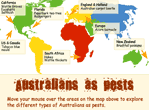Australian species as invaders
Invasions can come from unlikely sources and by participating in this exercise you may re-evaluate your current view of what constitutes an invading species.
Many people regard the concept of Australian species as invasive species ("pests" or "weeds") as humorous. How could something we know so well and consider to be in harmony with our landscape be a threat elsewhere?
Homesick Australians greet the smell of Eucalyptus in San Diego, USA and Quito, Ecuador as a welcome reminder of life at home. If their American or Ecuadorian host dismissed these beautiful trees as unwanted invaders, they would probably feel affronted.
As you will have discovered from the timeline and reading, there are many motivations for transporting species within and between continents, and in Australia we have rapidly transformed the native biota in the 200 years since European colonisation.
In Feral Future, Tim Low provides an interesting overview of our attitudes to Australian species as invaders, gives some really interesting examples, and discusses the difficult topic of natives as invasive species.
Begin to explore the issue of whether Australian plants, animals and microbes have a negative impact on the rest of the world or even within Australia by exploring the graphic below and completing Reading 1.4: Low (2001).
Activity 1.2
Use Feral Future and other sources, scientific articles, magazines, or web-sites to answer the following questions.
- Describe any examples that you have personally seen where native species from your country of origin (eg Australia) have established as pests in other countries (if you haven't experienced any, just note this in your response).
- What was the reaction of the local people in the invaded area to these species?
- What was your reaction to the idea that countries species could be pests? Did you feel concerned about it, or was it less worrying to you than the invasive species in your country (eg cane toads)?
